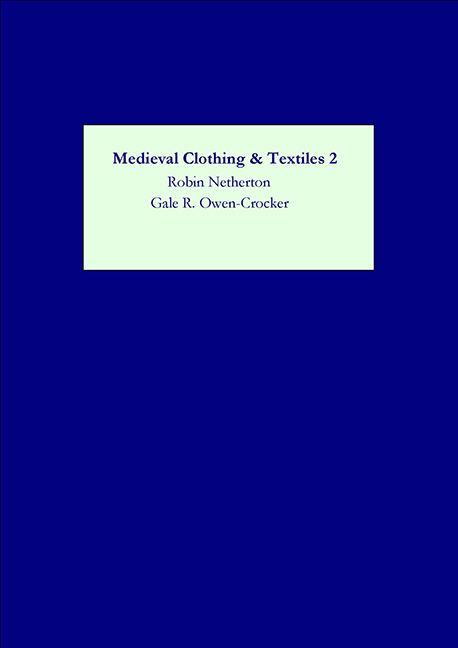Book contents
- Frontmatter
- Contents
- Illustrations page
- Tables
- Contributors
- Preface
- 1 Dress and Accessories in the Early Irish Tale 'The Wooing Of Becfhola”
- 2 The Embroidered Word: Text in the Bayeux Tapestry
- 3 “De Fil d'Or et de Soie”: Making Textiles in Twelfth-Century French Romance
- 4 Biffes, Tiretaines, and Aumonières: The Role of Paris in the International Textile Markets of the Thirteenth and Fourteenth Centuries
- 5 'Clothing Themselves in Acres”: Apparel and Impoverishment in Medieval and Early Modern England
- 6 'Ye Shall Have It Cleane”: Textile Cleaning Techniques in Renaissance Europe
- 7 Fleas, Fur, and Fashion: Zibellini as Luxury Accessories of the Renaissance
- 8 The Matron Goes to the Masque: The Dual Identity of the English Embroidered Jacket
- Recent Books of Interest
- Index
4 - Biffes, Tiretaines, and Aumonières: The Role of Paris in the International Textile Markets of the Thirteenth and Fourteenth Centuries
Published online by Cambridge University Press: 14 February 2019
- Frontmatter
- Contents
- Illustrations page
- Tables
- Contributors
- Preface
- 1 Dress and Accessories in the Early Irish Tale 'The Wooing Of Becfhola”
- 2 The Embroidered Word: Text in the Bayeux Tapestry
- 3 “De Fil d'Or et de Soie”: Making Textiles in Twelfth-Century French Romance
- 4 Biffes, Tiretaines, and Aumonières: The Role of Paris in the International Textile Markets of the Thirteenth and Fourteenth Centuries
- 5 'Clothing Themselves in Acres”: Apparel and Impoverishment in Medieval and Early Modern England
- 6 'Ye Shall Have It Cleane”: Textile Cleaning Techniques in Renaissance Europe
- 7 Fleas, Fur, and Fashion: Zibellini as Luxury Accessories of the Renaissance
- 8 The Matron Goes to the Masque: The Dual Identity of the English Embroidered Jacket
- Recent Books of Interest
- Index
Summary
Historians of Western medieval textiles tend to emphasize two major centers of production in the thirteenth and fourteenth centuries: the Low Countries and Northern Italy. From the twelfth century until the first quarter of the fourteenth, the towns of Flanders, Artois, Brabant, and Champagne dominated international markets in the production of luxury and middle-level wool cloth. By the twelfth century, luxury silks from the Northern Italian town of Lucca were being sold at the Champagne fairs of Northern France. By the early fourteenth century, Lucchese silks dominated the northern aristocratic market for silks, and Lucca had been joined by three other Italian silk-weaving towns—Venice, Genoa, and Bologna. By the thirteenth century, Italian woolens and cottons were also being sold internationally.
While historians have acknowledged that Paris—the largest city in Western Europe—also had a cloth industry and that it played a major role in the emergence of the tapestry-weaving industry at the beginning of the fourteenth century, the full extent and the unusual range of Parisian textile production has generally been ignored. By the second half of the thirteenth century, Paris was at the top of the field in the production and export of middle-level woolens called biffes; it had a very significant linen industry with an international market; and it had a small but significant silk
A version of this paper was presented in May 2004 at the International Congress on Medieval Studies at Kalamazoo, Michigan.
industry, which, by the early fourteenth century, was selling cloth to the royal courts of England and France. Along with Arras, Paris dominated the tapestry industry in the first half of the fourteenth century, and it was also well known for its small luxury textile items, such as silk almspurses and silk belts.
The purpose of this article is to bring together the evidence for the market of Parisian textiles in order to demonstrate just how significant Paris was as a textile center during the second half of the thirteenth and the first four decades of the fourteenth centuries. I focus on this period because the sources are too scant before the middle of the thirteenth century, and most of the Parisian textile industries suffered a radical decline with the onset of the Hundred Years' War, which began in 1337.
- Type
- Chapter
- Information
- Medieval Clothing and Textiles 2 , pp. 73 - 90Publisher: Boydell & BrewerPrint publication year: 2006
- 2
- Cited by

